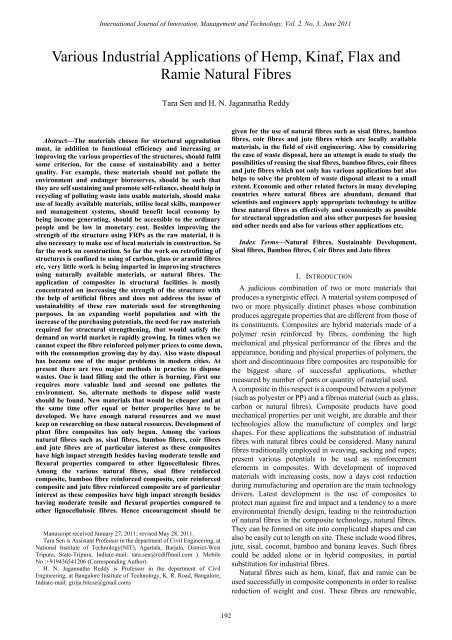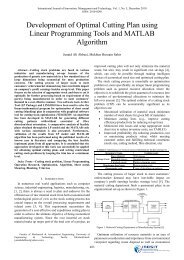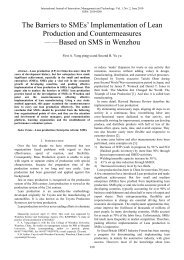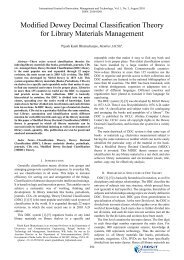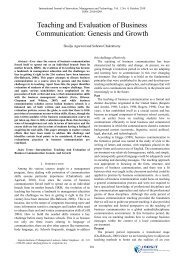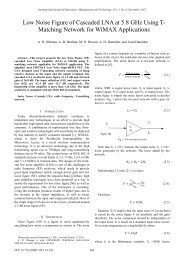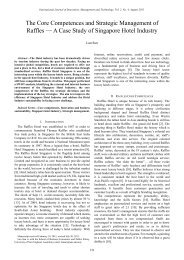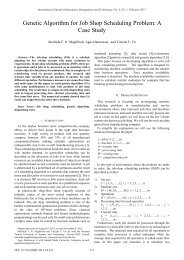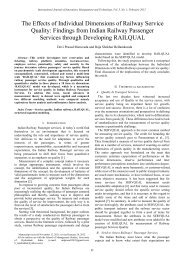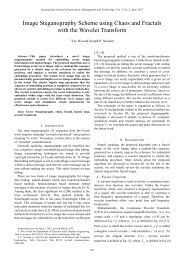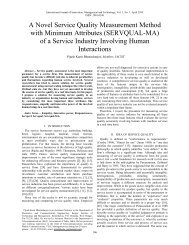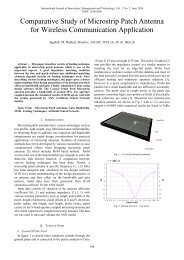Various Industrial Applications of Hemp, Kinaf, Flax and ... - ijimt
Various Industrial Applications of Hemp, Kinaf, Flax and ... - ijimt
Various Industrial Applications of Hemp, Kinaf, Flax and ... - ijimt
You also want an ePaper? Increase the reach of your titles
YUMPU automatically turns print PDFs into web optimized ePapers that Google loves.
International Journal <strong>of</strong> Innovation, Management <strong>and</strong> Technology, Vol. 2, No. 3, June 2011<strong>Various</strong> <strong>Industrial</strong> <strong>Applications</strong> <strong>of</strong> <strong>Hemp</strong>, <strong>Kinaf</strong>, <strong>Flax</strong> <strong>and</strong>Ramie Natural FibresTara Sen <strong>and</strong> H. N. Jagannatha ReddyAbstract—The materials chosen for structural upgradationmust, in addition to functional efficiency <strong>and</strong> increasing orimproving the various properties <strong>of</strong> the structures, should fulfilsome criterion, for the cause <strong>of</strong> sustainability <strong>and</strong> a betterquality. For example, these materials should not pollute theenvironment <strong>and</strong> endanger bioreserves, should be such thatthey are self sustaining <strong>and</strong> promote self-reliance, should help inrecycling <strong>of</strong> polluting waste into usable materials, should makeuse <strong>of</strong> locally available materials, utilise local skills, manpower<strong>and</strong> management systems, should benefit local economy bybeing income generating, should be accessible to the ordinarypeople <strong>and</strong> be low in monetary cost. Besides improving thestrength <strong>of</strong> the structure using FRPs as the raw material, it isalso necessary to make use <strong>of</strong> local materials in construction. S<strong>of</strong>ar the work on construction. So far the work on retr<strong>of</strong>itting <strong>of</strong>structures is confined to using <strong>of</strong> carbon, glass or aramid fibresetc, very little work is being imparted in improving structuresusing naturally available materials, or natural fibres. Theapplication <strong>of</strong> composites in structural facilities is mostlyconcentrated on increasing the strength <strong>of</strong> the structure withthe help <strong>of</strong> artificial fibres <strong>and</strong> does not address the issue <strong>of</strong>sustainability <strong>of</strong> these raw materials used for strengtheningpurposes. In an exp<strong>and</strong>ing world population <strong>and</strong> with theincrease <strong>of</strong> the purchasing potentials, the need for raw materialsrequired for structural strengthening, that would satisfy thedem<strong>and</strong> on world market is rapidly growing. In times when wecannot expect the fibre reinforced polymer prices to come down,with the consumption growing day by day. Also waste disposalhas become one <strong>of</strong> the major problems in modern cities. Atpresent there are two major methods in practice to disposewastes. One is l<strong>and</strong> filling <strong>and</strong> the other is burning. First onerequires more valuable l<strong>and</strong> <strong>and</strong> second one pollutes theenvironment. So, alternate methods to dispose solid wasteshould be found. New materials that would be cheaper <strong>and</strong> atthe same time <strong>of</strong>fer equal or better properties have to bedeveloped. We have enough natural resources <strong>and</strong> we mustkeep on researching on these natural resources. Development <strong>of</strong>plant fibre composites has only begun. Among the variousnatural fibres such as, sisal fibres, bamboo fibres, coir fibres<strong>and</strong> jute fibres are <strong>of</strong> particular interest as these compositeshave high impact strength besides having moderate tensile <strong>and</strong>flexural properties compared to other lignocellulosic fibres.Among the various natural fibres, sisal fibre reinforcedcomposite, bamboo fibre reinforced composite, coir reinforcedcomposite <strong>and</strong> jute fibre reinforced composite are <strong>of</strong> particularinterest as these composites have high impact strength besideshaving moderate tensile <strong>and</strong> flexural properties compared toother lignocellulosic fibres. Hence encouragement should beManuscript received January 27, 2011; revised May 28, 2011.Tara Sen is Assistant Pr<strong>of</strong>essor in the department <strong>of</strong> Civil Engineering, atNational Institute <strong>of</strong> Technology(NIT), Agartala, Barjala, District-WestTripura, State-Tripura, India(e-mail: tara.sen@rediffmail.com ). MobileNo :+919436541206 (Corresponding Author)H. N. Jagannatha Reddy is Pr<strong>of</strong>essor in the department <strong>of</strong> CivilEngineering, at Bangalore Institute <strong>of</strong> Technology, K. R. Road, Bangalore,India(e-mail: girija.bitcse@gmail.com)given for the use <strong>of</strong> natural fibres such as sisal fibres, bambo<strong>of</strong>ibres, coir fibres <strong>and</strong> jute fibres which are locally availablematerials, in the field <strong>of</strong> civil engineering. Also by consideringthe case <strong>of</strong> waste disposal, here an attempt is made to study thepossibilities <strong>of</strong> reusing the sisal fibres, bamboo fibres, coir fibres<strong>and</strong> jute fibres which not only has various applications but alsohelps to solve the problem <strong>of</strong> waste disposal atleast to a smallextent. Economic <strong>and</strong> other related factors in many developingcountries where natural fibres are abundant, dem<strong>and</strong> thatscientists <strong>and</strong> engineers apply appropriate technology to utilizethese natural fibres as effectively <strong>and</strong> economically as possiblefor structural upgradation <strong>and</strong> also other purposes for housing<strong>and</strong> other needs <strong>and</strong> also for various other applications etc.Index Terms—Natural Fibres, Sustainable Development,Sisal fibres, Bamboo fibres, Coir fibres <strong>and</strong> Jute fibresI. INTRODUCTIONA judicious combination <strong>of</strong> two or more materials thatproduces a synergistic effect. A material system composed <strong>of</strong>two or more physically distinct phases whose combinationproduces aggregate properties that are different from those <strong>of</strong>its constituents. Composites are hybrid materials made <strong>of</strong> apolymer resin reinforced by fibres, combining the highmechanical <strong>and</strong> physical performance <strong>of</strong> the fibres <strong>and</strong> theappearance, bonding <strong>and</strong> physical properties <strong>of</strong> polymers, theshort <strong>and</strong> discontinuous fibre composites are responsible forthe biggest share <strong>of</strong> successful applications, whethermeasured by number <strong>of</strong> parts or quantity <strong>of</strong> material used.A composite in this respect is a compound between a polymer(such as polyester or PP) <strong>and</strong> a fibrous material (such as glass,carbon or natural fibres). Composite products have goodmechanical properties per unit weight, are durable <strong>and</strong> theirtechnologies allow the manufacture <strong>of</strong> complex <strong>and</strong> largeshapes. For these applications the substitution <strong>of</strong> industrialfibres with natural fibres could be considered. Many naturalfibres traditionally employed in weaving, sacking <strong>and</strong> ropes;present various potentials to be used as reinforcementelements in composites. With development <strong>of</strong> improvedmaterials with increasing costs, now a days cost reductionduring manufacturing <strong>and</strong> operation are the main technologydrivers. Latest development is the use <strong>of</strong> composites toprotect man against fire <strong>and</strong> impact <strong>and</strong> a tendency to a moreenvironmental friendly design, leading to the reintroduction<strong>of</strong> natural fibres in the composite technology, natural fibres.They can be formed on site into complicated shapes <strong>and</strong> canalso be easily cut to length on site. These include wood fibres,jute, sisal, coconut, bamboo <strong>and</strong> banana leaves. Such fibrescould be added alone or in hybrid composites, in partialsubstitution for industrial fibres.Natural fibres such as hem, kinaf, flax <strong>and</strong> ramie can beused successfully in composite components in order to realisereduction <strong>of</strong> weight <strong>and</strong> cost. These fibres are renewable,192
International Journal <strong>of</strong> Innovation, Management <strong>and</strong> Technology, Vol. 2, No. 3, June 2011non-abrasive to process equipment, <strong>and</strong> can be incinerated atthe end <strong>of</strong> their life cycle for energy recovery as they possessa good deal <strong>of</strong> calorific value. They are also very safe duringh<strong>and</strong>ling, processing <strong>and</strong> use. The distinctive properties <strong>of</strong>natural fibre reinforced polymers are improved tensile <strong>and</strong>bending strength, greater ductility <strong>and</strong> greater resistance tocracking <strong>and</strong> hence improved impact strength <strong>and</strong> toughness.By changing the direction <strong>of</strong> the fibres in the resin, thematerial properties can be tailored to the external loads. Tooptimize the construction multiple adjusted layers (laminae)can be used to form a laminate. By this joining, the poorcapabilities <strong>and</strong> drawbacks <strong>of</strong> the individual componentsdisappear. By this joining, the poor capabilities <strong>and</strong>drawbacks <strong>of</strong> the individual components disappear. Forinstance, composites combine a high stiffness <strong>and</strong> strengthwith a low weight <strong>and</strong> their corrosion resistance is <strong>of</strong>tenexcellent. Composites have worked their way up amongstwood <strong>and</strong> metal due to their outst<strong>and</strong>ing price performanceratio during a lifetime. A powerful approach in improvingthis ratio is to minimise the steps required from raw materialto end product.The use <strong>of</strong> residues from the processing <strong>of</strong> vegetable fibrein civil construction could contribute to the increase <strong>of</strong>income in the agricultural industry, together with theagricultural producers. Studies are continuing to establish thedurability <strong>of</strong> vegetable fibre reinforcement, which isnormally attacked by the alkaline surrounding <strong>of</strong> Portl<strong>and</strong>cement matrix. The improvement <strong>of</strong> composites reinforcedby vegetable rejects can still lead to a sustainabledevelopment in predominantly agricultural regions. Thestudies on sugar cane bagasse show the viability <strong>of</strong>composites as a substitute <strong>of</strong> wood chip board. Jute, curaua,sisal, coconut <strong>and</strong> banana fibres are the most studied asreinforcement in cementitious composites. There are othervegetable fibres which present great potentials for thispurpose. Natural fibres are generally lignocellulosic in nature,consisting <strong>of</strong> helically wound cellulose micro fibrils in amatrix <strong>of</strong> lignin <strong>and</strong> hemicellulose. According to a Food <strong>and</strong>Agricultural Organization survey, Tanzania <strong>and</strong> Brazilproduce the largest amount <strong>of</strong> sisal. Henequen is grown inMexico. Abaca <strong>and</strong> hemp are grown in the Philippines. Thelargest producers <strong>of</strong> jute are India, China, <strong>and</strong> Bangladesh.Presently, the annual production <strong>of</strong> natural fibres in India isabout 6 million tons as compared to worldwide production <strong>of</strong>about 25 million tons. The mechanical properties <strong>of</strong> a naturalfibre-reinforced composite depend on many parameters, suchas fibre strength, modulus, fibre length <strong>and</strong> orientation, inaddition to the fibre-matrix interfacial bond strength. Astrong fibre-matrix interface bond is critical for highmechanical properties <strong>of</strong> composites. A good interfacial bondis required for effective stress transfer from the matrix to thefibre whereby maximum utilization <strong>of</strong> the fibre strength inthe composite is achieved. Modification to the fibre alsoimproves resistance to moisture induced degradation <strong>of</strong> theinterface <strong>and</strong> the composite properties. In addition, factorslike processing conditions/techniques have significantinfluence on the mechanical properties <strong>of</strong> fibre reinforcedcomposites.II. DIFFERENT TYPES OF NATURAL FIBREA. <strong>Hemp</strong><strong>Hemp</strong> is a member <strong>of</strong> the Cannabaceae family <strong>and</strong> is aplant which produces bast fibres. Bast fibres are s<strong>of</strong>t woodyfibres obtained from the stems <strong>of</strong> dicotyledonous plants.<strong>Hemp</strong> originated in Central Asia <strong>and</strong> was grown for its fibressince 2800 BC. It was cultivated in the Mediterraneancountries during the middle Ages. <strong>Hemp</strong> (also known asCannabis) was one <strong>of</strong> the first plants to be cultivated by thehuman race <strong>and</strong> was previously considered to be one <strong>of</strong> themost important agricultural crops. The Celts consideredhemp to be a mystical plant <strong>and</strong> Queen Elizabeth I decreedthat all farmers were obliged to grow hemp on their farms.Until the 1800s, Cannabis was used to produce rope, cloth,food, lighting oil <strong>and</strong> medicine <strong>and</strong> was one <strong>of</strong> the maincultivated plants throughout the western world. Guttenberg’sfirst Bible was published upon hemp paper <strong>and</strong> currentlyhemp fibres are used to manufacture bank notes. <strong>Hemp</strong> is anextremely useful plant, as it provides fibres, oil <strong>and</strong> hardwood.Its fibres are very strong with a tensile strength <strong>of</strong> 550 – 900MPa <strong>and</strong> were valued hugely before the development <strong>of</strong>plastic fibres from petrochemicals. From the 1930s,Cannabis sativa disappeared from the world markets. Withthe increase <strong>of</strong> petrochemical fibres, the importance <strong>of</strong>natural fibres declined <strong>and</strong> as a result Cannabis became a lessimportant crop. The banning <strong>of</strong> the plant in the US coincidedwith the release <strong>of</strong> the first plastic fibres from DupontPharmaceuticals. At the time <strong>of</strong> the US banning <strong>of</strong> Cannabissativa, a Dupont senator was a direct advisor to the president<strong>and</strong> advocated the ban, on grounds <strong>of</strong> drug misuse. In 1937, aUS tax made growing hemp (the drug-free form <strong>of</strong> Cannabissativa) prohibitively expensive preventing any further growth<strong>of</strong> the plant in America. Ranalli states that ‘The prohibition <strong>of</strong>Cannabis drugs has led to the prohibition <strong>of</strong> Cannabiscultivation in general, <strong>and</strong> the historically important uses <strong>of</strong>Cannabis have been largely forgotten…’ The plant itself canbe grown without artificial fertilisers <strong>and</strong> weeds don’t st<strong>and</strong> achance because hemp covers the entire ground within 4weeks. The production is very labour intensive, especially theseparation <strong>of</strong> the fibres from the bast. After mowing, thestems are bundled <strong>and</strong> dried. The seeds are removed bythreshing <strong>and</strong> the stems are dew or water retted, dried <strong>and</strong>hackled to remove the fibres. Breaking s<strong>of</strong>tens the fibres <strong>and</strong>the top <strong>and</strong> bottom (bad) parts are removed. A <strong>Hemp</strong> yarn isstrong <strong>and</strong> has <strong>of</strong> all natural fibres the highest resistanceagainst water, but it shouldn’t be creased excessively to avoidbreakage. As hemp is a plan not require pesticides <strong>and</strong>requires little fertilising. A hemp crop can be grown inIrel<strong>and</strong> in roughly 100 days. One hectare <strong>of</strong> hemp produces3.5 tons <strong>of</strong> hurds. The current decortications process <strong>of</strong>sepahemp into its separate parts <strong>of</strong> long fibres <strong>and</strong> woodyhurds results in the hurds as a by-product. The only directenergy required for processing is inspection <strong>of</strong> the material,packaging <strong>and</strong> transportation. Hurds are now available from alarge hemp producer in Engl<strong>and</strong> (Hemcore), <strong>and</strong> there areseveral suppliers throughout Irel<strong>and</strong>. This material hasnegative impact on the environment in terms <strong>of</strong> CO 2production. The fibre is used for the production <strong>of</strong> rope,fishing nets, paper, sacks, fire hoses <strong>and</strong> textile. Fibre stemsdrying on the field separating the fibres from the stem.193
International Journal <strong>of</strong> Innovation, Management <strong>and</strong> Technology, Vol. 2, No. 3, June 2011Throughout the world, hemp is cultivated commercially forits strong, valuable fibres <strong>and</strong> oil. These hurds are a naturalby-product after the plant has been used for other purposes.The hemp was used for two main roles. Firstly, hemp hurdswere mixed with a hydraulic lime binder as an aggregate;secondly, fibres were added as a tensile reinforcement in alime/hemp hurd mix. This investigation was designed toexamine the strength <strong>of</strong> a typical lime/hemp hurd mix <strong>and</strong> todetermine if hemp fibres can strengthen it. <strong>Hemp</strong> howeverhas certain distinct advantages. It is stronger than sisal <strong>and</strong>ramie, <strong>and</strong> it is much cheaper to grow <strong>and</strong> process than flax.<strong>Hemp</strong> also grows with a much higher yield per acre than flax.Properties <strong>of</strong> this fibre are as follows :Density [kg/m3] 1480Tensile strength [N/mm2] 550-900Stiffness [kN/mm2] 70Moist absorption [%] 8Available countries:-Yugoslavia, china, Nigeria, Guyana, Siera Leone, India1) Advantagesa) Its fibres are very strong with a tensile strength <strong>of</strong> 550 –900 MPab) A <strong>Hemp</strong> yarn is strong <strong>and</strong> has <strong>of</strong> all natural fibres thehighest resistance against water.c) <strong>Hemp</strong> is a plant which does not require pesticides <strong>and</strong>requires little fertilizing.d) Its growth is faster than any other any other naturalfibre.e) <strong>Hemp</strong> requires less moisture to grow than kenaf.f) <strong>Hemp</strong>’s fibre-bundles are stronger <strong>and</strong> tougher thanthose <strong>of</strong> kenaf, generally comparable to varieties <strong>of</strong> flax,<strong>and</strong> most other known fibre species.g) <strong>Hemp</strong> is generally pest resistant, drought resistant, <strong>and</strong>light frost resistant.h) With proper leaf removal, hemp has low net nutrientrequirements <strong>and</strong> requires minimal cultivation.i) <strong>Hemp</strong> provides greater fibre yields in areas generallynorth <strong>of</strong> the 40th latitude than most other fibre crops,generally surpassing flax by 10%.2) Disadvantagesa) The production is very labour intensive, especially theseparation <strong>of</strong> the fibres from the bast.b) It shouldn’t be creased excessively to avoid breakage.c) Restrictions <strong>of</strong> its growth <strong>and</strong> cultivation in NorthAmerica, especially in the United States.d) Lower fibre yields than kenaf <strong>and</strong> other tropical speciesin the warmer portions <strong>of</strong> the United States <strong>and</strong> moresoutherly regions.e) Lower bast fibre portions relative to kenaf <strong>and</strong> flax.3) <strong>Applications</strong>a) <strong>Hemp</strong> is used to produce rope, cloth, food, lighting oil<strong>and</strong> medicine.b) Currently hemp fibres are used to manufacture banknotes.c) These are valued hugely before the development <strong>of</strong>plastic fibres from petrochemicals.d) <strong>Hemp</strong> hurds can be mixed with hydraulic lime binder asan aggregatee) <strong>Hemp</strong> fibres were added as a tensile reinforcement in alime/hemp hurd mix.B. KenafKenaf [Etymology: Persian] Hibiscus cannabinus, is aplant in the Malvaceae family. Hibiscus cannabinus is in thegenus Hibiscus <strong>and</strong> is probably native to southern Asia,though its exact natural origin is unknown. The name alsoapplies to the fibre obtained from this plant. Kenaf is one <strong>of</strong>the allied fibres <strong>of</strong> jute <strong>and</strong> shows similar characteristics.Other names include Bimli, Ambary, Ambari <strong>Hemp</strong>, Deccan<strong>Hemp</strong>, <strong>and</strong> Bimlipatum Jute. It is labelled as Gongoora inIndian, Korean, American food <strong>and</strong> groceries chains in theUnited States. Gongoora is from Telugu. It is a high-yieldingtropical plant traditionally grown for the long, strong bastfibres that develop in the bark layer <strong>of</strong> the stem. Cultivationspread internationally in the early to mid-twentieth century,but interest waned, particularly in developed counties, as rawmaterials for cordage <strong>and</strong> related products shifted frombiological to petrochemical sources. Concerns over risingcosts, unstable supply, <strong>and</strong> negative environmental impact <strong>of</strong>fossil fuels are promoting renewed interest in traditional fibrecrops. Kenaf is a multipurpose crop with various harvestablecomponents: leaves <strong>and</strong> tender shoots are suitable for forage;the woody core has attributes for forest-product substitutes,absorbents, <strong>and</strong> structural materials; <strong>and</strong> seeds have an oil<strong>and</strong> protein composition similar to cotton seed. The bastfibres, however, remain the primary economic incentive togrow kenaf. Beyond cordage, bast fibres are exp<strong>and</strong>ing intonew markets <strong>of</strong> mouldable, nonwoven fabrics, <strong>and</strong> reinforcedcomposite materials in automotive, aerospace, packaging <strong>and</strong>other industrial applications. This trend is in part due to thefibre’s physical properties <strong>of</strong> light weight, competitive tensilestrength <strong>and</strong> stiffness, <strong>and</strong> vibration damping properties, <strong>and</strong>also due to the fibre being a renewable <strong>and</strong> biodegradableresource. Nonwoven materials made <strong>of</strong> kenaf or other naturalfibres blended with polyester or polypropylenes are efficientsound absorbers <strong>and</strong> can meet industry specifications <strong>of</strong>flammability, <strong>and</strong> odour <strong>and</strong> mildew resistance. It is anannual or biennial herbaceous plant (rarely a short-livedperennial) growing to 1.5-3.5 m tall with a woody base. Thestems are 1–2 cm diameter, <strong>of</strong>ten but not always branched.The leaves are 10–15 cm long, variable in shape, with leavesnear the base <strong>of</strong> the stems being deeply lobed with 3-7 lobes,while leaves near the top <strong>of</strong> the stem are shallowly lobed orunlobed lanceolate. The flowers are 8–15 cm diameter, white,yellow, or purple; when white or yellow, the centre is stilldark purple. The fruit is a capsule 2 cm diameter, containingseveral seeds. Kenaf was grown under two differentconditions, at an average temperature <strong>of</strong> 22 °C (condition A)<strong>and</strong> at an average temperature <strong>of</strong> 30 °C (condition B). Thegeographical locations <strong>of</strong> conditions A <strong>and</strong> B are MiyagiPrefecture <strong>and</strong> Ehime Prefecture in Japan, respectively. The194


